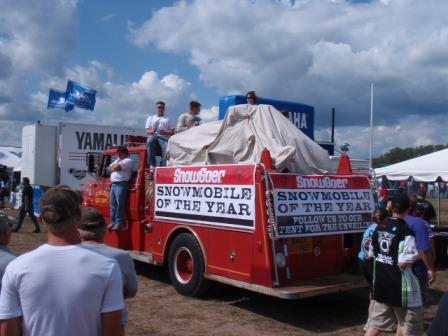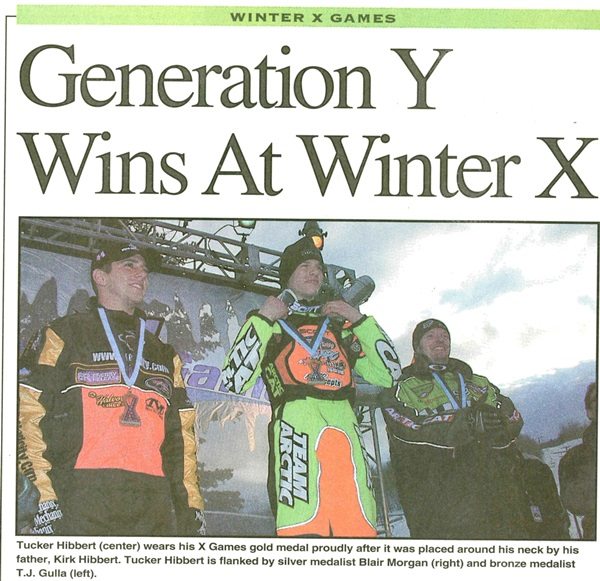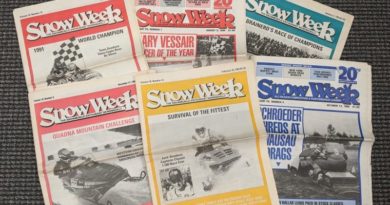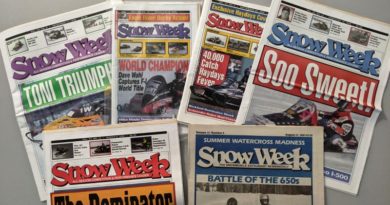Recalling 2000 Snow Week Racer Of The Year Mike Houle
Snowmobile racing was a crowd-pleaser when the new millennium started. There was fierce competition in snocross, ovals, cross-country, enduro, drags, speed runs, watercross, hillclimbs, hillcross and more. Snow Week magazine was there to cover it all. At the end of each year the staff would select a Racer Of The Year and Top 10 based on who stood out in the various disciplines.
After the 1999-2000 season, Mike Houle was selected for the honor based on his near-perfect season, and the fact that it came after overcoming a huge injury the season before. The complete story, torn from the pages of Snow Week magazine Volume 27, Issue No. 18, is below. The cover date was April 17, 2000. (We’ve got three hard copies of the issue “in stock” on the Snow Goer Store site, if you want your own copy).
Houle remains active in the sport today as one of the chief chassis builders and modifiers for top Ski-Doo oval racers. Now, to the Snow Week story:
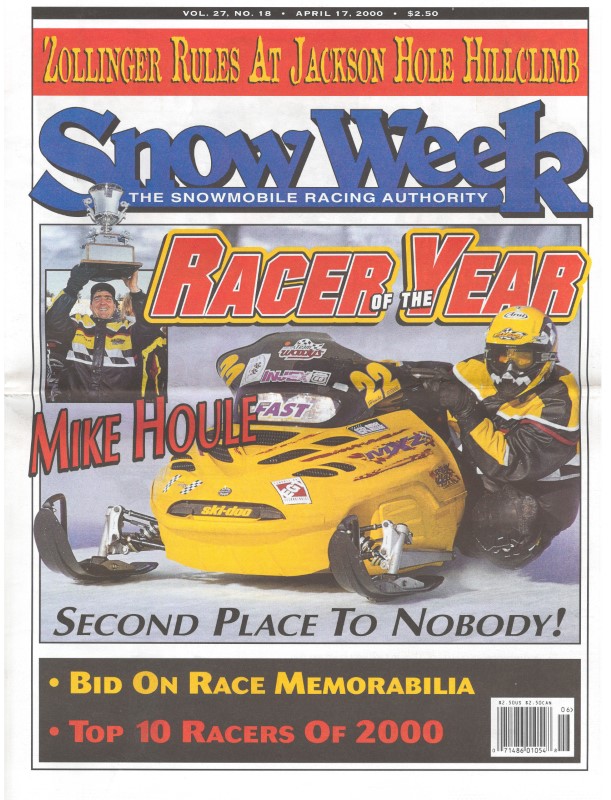
Mike Houle: 2000 Snow Week Racer Of The Year
He never saw it coming.
Fourteen months ago, veteran oval racer Mike Houle was on the move, trying an inside pass on Landon Benoit entering turn three at the famous Circuit Yvon Duhamel in Valcourt, Quebec. He won his first heat in Champ 440 and he was looking to overcome a bad holeshot in this race with a bold first-lap pass.
Then Benoit’s track let loose, and Benoit and his sled careened into Houle, the defending Eagle River World Champion.
“I was in a bad spot, I guess,” Houle calmly says now.
The impact separated Houle from his sled and sent the 200-pound driver airborne over the top of the haybales that lined the outside of the track. In a normal winter, Houle would have landed on the snow beyond the bales. This was not a normal year.
Houle landed on rock-hard frozen dirt, and his leg snapped about 6 inches beneath his right knee.
“I’d show you the scars, but we’re eating – you wouldn’t want to see it right now,” Houle said recently from across the booth at a Ham Lake, Minnesota, restaurant.
“I don’t remember a lot of it after that,” Houle related. “I remember being in an ambulance. They tell me that I was awake the whole time, and that I kept saying, ‘My leg hurts. What happened? My leg hurts. What happened?’”
His shin bone was sticking through the skin.
“The guy in the ambulance scissored my leathers off, and then he grabbed the phone and started talking real fast in French,” Houle recalled. “That’s when I thought, ‘uh-oh.’”
Houle had been injured before. Snowmobile racing accidents had crushed Houle’s ankle, damaged his shoulder, fractured ribs and hurt his back. But this was serious. The leg wasn’t just broken – the end of the bone was shattered. Recovery was slow and arduous. He was on crutches well into the summer. Plus, there was nothing he could do – no physical therapy would repair a slow-healing bone. He’d just have to wait it out.
Who would have thought a season that ended so miserably would give birth to a season like this?
Houle won all 38 finals he finished this winter. That’s right, every time he took a checkered flag, he took it first, including his second consecutive Eagle River World Championship.
And, other than a weather-spoiled stop at Beausejour, Manitoba, Houle’s fabulous run ended at the site of last year’s painful conclusion. But this year, Houle entered nine finals at Valcourt, and won all nine.
While much of snowmobiling was focused on snocross and the high-flying antics on bumpy courses, Houle had a near perfect season in ovals, beating legends named Wahl, Loritz, Villeneuve, Ludwig, Nicholsen, Schmit, DeVault, Ramesh, Racine, Clarke and VanDolder, among others.
We set the bar high for drivers to earn Snow Week Racer Of The Year honors, and Houle cleared it with ease for 2000, earning the award for a third time.
Mike Houle, The Gentle Giant
Inside his home near Wyoming, Minnesota, visitors would never guess Mike Houle races snowmobiles. There isn’t a single trophy inside the spacious, airy abode, which backs up to a beautiful lake that serves as Houle’s summer fishing outlet, and winter practice track.
Instead, his wife, Michelle, controls the house décor, and the seemingly passive and reserved racer controls his race shop.
“She doesn’t allow any of that stuff in here,” Houle said with a smile.
In fact, Houle is the antithesis of a racer stereotype. He doesn’t like fast cars, fast motorcycles, fast women or fast talk.
“You know, people think because I’m a racer that I want to drive anything that will go fast,” Houle said very seriously,” but in the summer, I just want to slow down.”
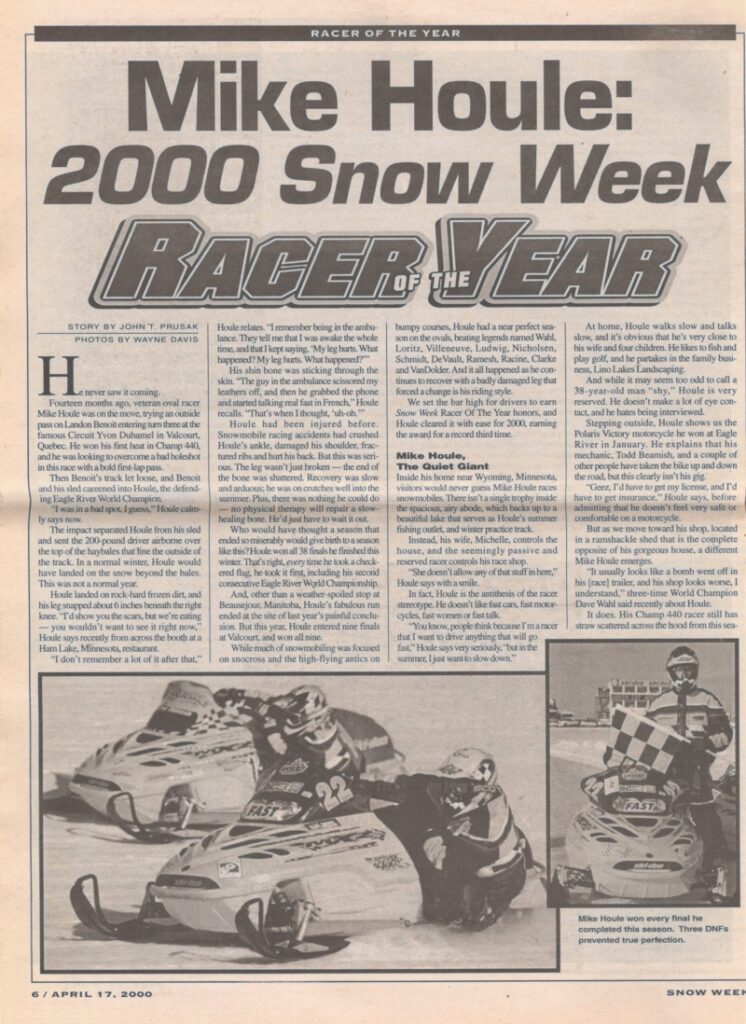
At home, Houle walks slow and talks slow. He likes to fish and play golf, and he partakes in the family business, Lino Lakes Landscaping.
And while it may seem too odd to call a 38-year-old man “shy,” Houle is very reserved. He doesn’t make a lot of eye contact and hates being interviewed.
Stepping outside, Houle shows us the Polaris Victory motorcycle he won at Eagle River in January. He explains that his mechanic, Todd Beamish, and a couple of other people have taken the bike up and down the road, but this is clearly not his gig.
“Geez, I’d have to get my license, and I’d have to get insurance,” Houle said, before admitting that he doesn’t feel very safe or comfortable on a motorcycle.
But as we move toward his shop, located in a ramshackle shed that is the complete opposite of his gorgeous house, a different Mike Houle emerges.
“It usually looks like a bomb when off in his trailer, and his shop looks worse, I understand,” three-time World Champion Dave Wahl said recently about Houle.
It does. His Champ 440 race sled still had straw scattered across the hood from the season’s year-ending crash at Beausejour. Dust-covered trophies are stuffed into the corners, and miscellaneous parts and pieces of scrap paper litter the space.
Yet there seems to be a strange organization to it all, and Houle is clearly in charge of his surroundings. Here he fabricates his race chassis, modifies his front suspensions and builds his rear suspensions. That motor work is done elsewhere.
Inside this shack, ideas are put into action, and the groundwork for countless victories is laid.
At The Track
Houle’s dream season got off to a slow start.
He was still gimping around late into the fall. Houle walks without a limp now, but he still can’t apply much pressure to the leg. His right leg is substantially weaker than the left, and he’ll have a steel rod and some screws removed from his leg in mid-April.
Last summer, rumors about Houle’s condition floated throughout racing circles, and there was talk about impending retirement.
But Houle never balked. Shortly after the crash at Valcourt, Houle told Ski-Doo he was coming back for another season.
“It was a matter of pride,” Houle said. “After I broke my leg, I knew I didn’t need to race to prove anything to anybody. But I didn’t want it to end like that. One more year and I’m done. That was my plan.”
With many changes throughout Ski-Doo, it took a while to finalize Houle’s deal with the factory, but he signed in September.
Then Houle turned his focus to racing. He repaired his mangled Champ 440 sled and replaced the engine with a case-reed motor. While his engine builder, Greg Atkinson of Trackside Performance in Becker, Minnesota, focused on modifying the powerplant and building the pipes, Houle toiled away at his shop, building a new Mod 500 chassis. He soon received a new MX Zx 440 from Ski-Doo and also prepped that for racing.
Houle worked weekdays at Lino Lakes Landscaping. On weekends, Houle met Atkinson at Todd Beamish’s house near Loretto, Minnesota. Beamish, Houle’s main wrench and an astute power-builder himself, has a full-sized dyno at his shop, and Atkinson, Beamish and Houle tried different pipe combinations and theories there.
The race season rolled around too soon. Due to his injuries, plus record warm temperatures in December, Houle was uncharacteristically unprepared when the season started at Beausejour.
“I didn’t know how well I was going to be able to ride,” Houle said. “I took some Advil, and then we went to a pond in Roseau [Minnesota] the day before the race.” After some quick test runs, the crew trailered farther north to Beausejour, and had a miserable day. First the Champ 440 sled burned down, thanks to an intermittent carburetion problem. His Stock-class sled developed ignition problems. Houle didn’t complete a single final.
But even Beausejour officials admit their December race is mostly a formal testing and tuning day. The United States Snowmobile Association (USSA) season started in early January in Christmas, Michigan, and Houle was working his way into shape.
“On the stocker, I would go around for about two laps, then I’d look back and there was nobody there,” Houle says of his speedy new MX Zx. He had similar success with his Champ sled. He won all six finals he entered, including two Champ 440, two Pro Stock and one each in Mod 500 and Stock 500.
Also at Christmas, Houle learned about his new physical limitations. Unknowingly, he had previously developed a riding style that relied on his strong legs – he used his legs to keep himself away from the handlebars and also to support himself on bumpy tracks. That had to change.
“I was attached to the sled more, taking the bumps more than normal, but it was working,” Houle said. “I don’t know if my leg should ever get better,” he jokes now. “I had a pretty damn good year!”
Next, Houle followed the USSA circuit to Plymouth, Wisconsin. He started six finals, and he won five. The loss? Another DNF (did not finish), thanks to the burn down of his Champ 440 sled on Sunday.
“We pushed the jetting a little bit as a test, since Eagle River was the next week,” Houle explained, “but the air density changed between our last heat and the final.”
Now Houle knew the limit of his jetting, and he focused on a repeat at Eagle.
In time trials, Houle’s Champ sled was far too loose, so the crew kept tweaking over the weekend. He rolled through qualifying in all his classes. Sunday arrived, and the master was on his game. He blistered through Mod 500, Stock 500 and Pro Stock, collecting checkered flags and contingency checks along the way. His focus, however, was on Champ 440 – the only real World Championship.
Things didn’t go as planned.
“The year before, the sled handled great,” Houle recalled. “This year, I went into the first corner and it didn’t want to turn. I thought, ‘25 laps of that? Uh-oh, what do I do?’”
Still, Houle launched into the lead and set a fast pace. “When the sled pushes, I can’t get on the throttle as early coming out of the turns, and that makes me slower,” he explained.
Then young racer Jeremy Johnston blasted past the champion.
“When he came by me, I thought, ‘I’m just going to try to finish. I slowed down even more then. It was such a long race; I was having trouble just making it around.”
Houle’s sled handled poorly, and it wasn’t the fastest sled on the track either, he admits. Plus, he had trouble on the Derby’s high-banked turns. With little strength in his right leg, Houle couldn’t push himself away from the handlebars, and the bars kept hitting him in the stomach in turns.
Suddenly, his brother Andy started giving signals from beside that track showing Houle that he had a big lead.
“Andy started holding the ski boots way apart again,” Houle says. “It was the first time he had given me signals at a race, so I didn’t know if l should trust him. Did that mean that I was that far behind? Then, each lap, the boots start getting closer and closer again, so I knew somebody was coming. Next, all of a sudden, the boots go far apart again. Then I really slowed down.”
The first signal showed Houle the distance of his new lead that he unknowingly gained when Johnston crashed in turn two. When the distance between the ski boots narrowed, that meant Jeff Ludwig was closing. When they went wide again, that signaled when Ludwig burned down.
Then Houle took the checkered flag.
“I couldn’t believe it,” Houle says. “The first time we won it [in 1999], we were fast and the sled was handling great. This time, I didn’t feel that proud of myself. We weren’t that fast, and the sled wasn’t handling. But I’ve been ahead and not finished, so I know what that feels like. I felt for those guys.”
Closing It Out
Yet despite winning his second World Championship, Houle was determined to get faster.
“After that, everybody felt like they could get me, so we had to get faster.”
Before the USSA stop in Antigo, Wisconsin, Houle, Atkinson and Beamish eliminated a creeping RPM problem by swapping their Polaris clutches for Ski-Doo clutches.
Meanwhile, Houle could hardly walk after Eagle River. His legs ached like never before. But with his sled running at its best, he fought the pain, and the rout was on. Houle won all six of his finals at Antigo, then went five-for-five at the circuit’s return to Christmas, Michigan. Then, Houle returned to Valcourt.
Any second thoughts or flashbacks to the previous year’s crash disappeared when Houle took to the track.
“That just happens until you start racing,” Houle says. “‘Be careful;’ even if I tell myself that, once you get out there you drive like you always do. Once I get out there, I can’t control myself!”
In nine races, Houle collected nine checkered flags at Valcourt, starting with a Champ 440 Dash For Cash on Friday night and concluding with the Champ 440 Championship Sunday afternoon.
In the end, Houle won 26 of the 27 finals he entered on USSA, with one burn down preventing perfection. Add in nine victories at Valcourt, plus three wins in the finals he entered at Beausejour in March, and he’s got an amazing winning percentage. And the three races he didn’t win (at Beausejour and Plymouth), he didn’t finish.
Surrounded By Greatness
Houle has a large number of people to thank.
Beamish is his main wrenching partner, and Atkinson is his engine genius.
“Greg knows what’s going on in a motor more than anybody I have ever seen,” Houle said.
He also received help from a plethora of “third men” in the pits at various events, including Bill Rader, Andy Houle, Kevin Conrad, Jerry Dussesoy and Victor Bulow. He also had one ace in the Houle, er, hole, from his brother, Steve Houle, owner of Hot Seat Performance and Speedwerx. Steve gave Mike some prototype titanium clutch springs that worked excellently.
Houle also has a broad range of longtime sponsors, including Ski-Doo, FAST Inc., Energy Release, Woody’s, EGT, V-Force Reeds, Trackside Performance, Injex Oil and Phillips Racing Fuel.
And what about that plan? Remember, Mike? Race one season and then stop?
“I had such a good year, it’s too tough to stop now,” he said, then made an excuse. “Plus, a lot of guys want another shot at me, probably. And they have a good shot at me, too. I’m getting old.”
Editor’s Note: Every Snow Goer issue includes in-depth sled reports and comparisons, aftermarket gear and accessories reviews, riding destination articles, do-it-yourself repair information, snowmobile technology and more. Subscribe to Snow Goer now to receive print and/or digital issues.

